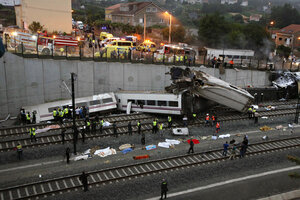On eve of holiday, deadly train crash in Santiago shatters Spain
At least 79 people were killed in the derailment of a train carrying tourists and pilgrims to the Galician city.

Emergency personnel respond to the scene of a train derailment in Santiago de Compostela, Spain, on Wednesday.
Antonio Hernandez/El correo Gallego/AP
Madrid
At least 79 people are dead and 36 more are in serious condition after a high-speed train derailed in Spain as it was entering the northwestern Galicia city of Santiago de Compostela at the beginning of a religious holiday weekend.
Rescue operations were ongoing more than 12 hours after the Wednesday evening accident, which occurred about 2.5 miles from the main Santiago station. All eight passenger cars of the Madrid-Galicia train, carrying 226 people, went off the tracks. At least 130 people were injured, 95 of whom are still being treated. Of the seriously injured, four are children, authorities said.
It’s the worst rail accident in Spain in more than 40 years and in Europe since 2000.
“For someone from Santiago like me, this is the saddest of days,” said Spanish Prime Minister Mariano Rajoy, who was born in the city, after inspecting the crash site along with regional leaders and some of his top ministers. “The solidarity of all Spaniards will always accompany you,” he said, addressing relatives and friends of the victims.
He also declared three days of national mourning and thanked citizens and emergency personnel for their “exemplary” help.
The devastating accident is also the first for Spain's much admired high-speed system, the longest in Europe and third largest in the world after China and Japan, with a network of more than 2,400 kilometers (1,500 miles). President Barack Obama at one point suggested it was a model for US high-speed rail plans. The trains can travel at 330 km/hour (nearly 200 miles per hour), and the web is spread throughout the country. The high-speed tracks connecting Ourense and Santiago, where the accident occurred, and its eight-car, two-locomotive line started operating in June 2012.
Terrorism and sabotage were ruled out almost immediately. Authorities are investigating whether speed was to blame.
Spanish media reported a radio exchange with one of the conductors, a veteran with 13 years on the job, immediately after the accident. In it he reportedly admitted traveling at 190 kilometers per hour (118 miles per hour) in a narrow curve where the speed limit is 80 k.m.h. (50 m.p.h.). A judge has already summoned him to testify, though he has not been charged with any crime.
Video footage shows the approaching train as it exited the curve, and then what appears to be the derailment of the car behind the first locomotive, which then simultaneously flipped the locomotive and the rest of the cars behind it, throwing them against a concrete barrier in a bridge overpass.
Officials Thursday, however, cautioned against jumping to conclusions. The conductor’s union also said that the accident had to be the result of a combination of factors, not just speed.
The track had been checked the morning before the accident, said the national railway company Renfe. The train was also connected to an emergency system that automatically slows down trains when they are speeding. It’s not clear if it worked. The black box is already in custody of a Spanish court.
Tragedy
Media images of a rail car torn in half being lifted by a crane to clear the tracks Thursday morning revealed the intensity of the accident. Cars could be seen scattered over hundreds of meters, resting against the lateral gravel walls; one car was piled on top of another, and another crumpled against an iron mesh. Another was propelled more than 15 yards.
Survivors quoted in Spanish media described a huge jolt. People and anchored-down chairs started flying around, followed by thunderous explosions and smoke plumes. Emergency crews, already on standby as Santiago began its annual festivities, and neighboring residents started pouring in within five minutes. Cries for help could be heard amid the clamor. Chaos prevailed for hours as hundreds of rescue personnel raced to untangle cars.
An amateur video filmed by a resident who arrived minutes after the accident embodied the anguish in the scene and throughout Spain. “What horror! My God, what horror!” the man is heard saying. “My God, please, please,” he said in tears, filming bodies covered with neighbors' blankets.
Television footage showed dozens of bodies covered with white sheets and emergency personnel pulling survivors and extinguishing fires well into the night. The victims are still being identified and hospitals scenes show desperate relatives waiting anxiously for information.
The train was packed with tourists, both Spanish and foreign, because it’s a religious and regional holiday in Galicia – July 25 is both Apostle Santiago day, in honor of Spain’s patron saint, and the National Galicia Day. This weekend is the beginning of the August vacation period, in which tourism peaks.
Many festivities were planned in Santiago, a city best known for being the final destination of the famous Camino de Santiago, a pilgrimage dating back to the Middle Ages that traces the steps of Saint James, one of Jesus’ 12 apostles. All festivities were canceled as the city went into mourning.
Country in shock
All Spain's regional leaders and many foreign governments relayed their sympathies. Vigils and minutes of silence were taking place throughout Spain, from parliament to civil organizations.
King Juan Carlos also issued a statement saying the country was “tainted by grief.”
“As human being and Spaniards, we are filled with pain and sorrow,” he said. The royal family will visit victims later today.
Pope Francis, currently visiting Brazil, also said he was praying for the victims and their relatives through Twitter.
Galicia regional government leader Alberto Nuñez Feijóo on Thursday declared an official seven-day mourning period, the longest in the region’s history. “The scene is shocking, it's Dante-esque,” he said.

